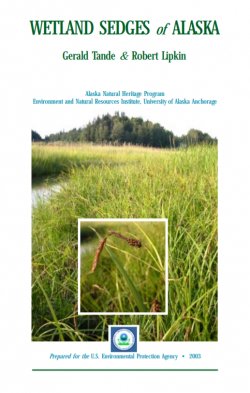Wetland Sedges of Alaska

Book Stores
Type
Book
Authors
Category
Plants
[ Browse Items ]
Publication Year
2003
Publisher
Alaska Natural Heritage Program, United States
Tags
Description
Alaska’s wetlands occupy 43.3 percent of its 403,247,700 acres (163,188,554
ha). Most regions of the state have extensive areas of bogs, fens, wet and moist
arctic and alpine tundra, lakes and ponds, wet forests, mudflats, and fresh and
saltwater marshes. As a result, there are many plants within Alaska that are adapted to wetlands or that are associated with wetland ecosystems.
Many of the most common and important plants of Alaska’s wetlands are sedges
(the Genus Carex). They are the predominant plant in many wetlands, with some
species forming nearly pure stands over large areas. Sedges are also the largest
Genus of plants in the state, and constitute the most diverse and important member
of the plant family Cyperaceae, which also includes the cotton-grasses, bulrushes,
clubrushes, spikerushes, et al. The USDA-NRCS (2003) National Plants Database
recognizes 155 species, subspecies, and varieties of sedges in Alaska, of which 113
may be found in wetlands.
Within Alaska, the sedges are not only diagnostic of different wetland types, but
also serve as the preferred food for many wetland animal species, and provide
important hydrologic and landscape modifying functions. Knowing the sedges, and
being able to identify them, is therefore fundamental in the identification of wetlands, as well as to understanding the functioning and importance of Alaskan
wetland ecosystems.
Sedges are, however, often regarded as difficult to identify and can be intimidating
to non-specialists, as well as to many professional biologists and wetland scientists
who conduct wetland studies. Popular picture guides to common plants are generally inadequate for accurate species identification, and typically include few, if
any, sedges.
Many of the existing technical guides to Alaska’s flora, such as Hultén (1968) and
Welsh (1974), may also be of limited use to non-botanically trained workers
because of their technical nature, lack of adequate illustrations and descriptions,
and the fact that they are in need of taxonomic revision. In some cases, the
identification keys in these works contain errors, resulting in misidentifications
and frustration to inexperienced workers. In the 25 to 30 years since their publication, new species have been identified, their taxonomy has changed, and our
knowledge of the habitat and ranges of many species has been expanded.
We prepared this guide to provide a treatment for some of the more common and ecologically important Alaskan wetland sedges likely to be encountered by wetland
scientists and naturalists. We also hope that this guide will further the involvement
and education of the public in the wetland protection process, by furnishing them
an accessible means to help appreciate, identify and evaluate wetlands.
ha). Most regions of the state have extensive areas of bogs, fens, wet and moist
arctic and alpine tundra, lakes and ponds, wet forests, mudflats, and fresh and
saltwater marshes. As a result, there are many plants within Alaska that are adapted to wetlands or that are associated with wetland ecosystems.
Many of the most common and important plants of Alaska’s wetlands are sedges
(the Genus Carex). They are the predominant plant in many wetlands, with some
species forming nearly pure stands over large areas. Sedges are also the largest
Genus of plants in the state, and constitute the most diverse and important member
of the plant family Cyperaceae, which also includes the cotton-grasses, bulrushes,
clubrushes, spikerushes, et al. The USDA-NRCS (2003) National Plants Database
recognizes 155 species, subspecies, and varieties of sedges in Alaska, of which 113
may be found in wetlands.
Within Alaska, the sedges are not only diagnostic of different wetland types, but
also serve as the preferred food for many wetland animal species, and provide
important hydrologic and landscape modifying functions. Knowing the sedges, and
being able to identify them, is therefore fundamental in the identification of wetlands, as well as to understanding the functioning and importance of Alaskan
wetland ecosystems.
Sedges are, however, often regarded as difficult to identify and can be intimidating
to non-specialists, as well as to many professional biologists and wetland scientists
who conduct wetland studies. Popular picture guides to common plants are generally inadequate for accurate species identification, and typically include few, if
any, sedges.
Many of the existing technical guides to Alaska’s flora, such as Hultén (1968) and
Welsh (1974), may also be of limited use to non-botanically trained workers
because of their technical nature, lack of adequate illustrations and descriptions,
and the fact that they are in need of taxonomic revision. In some cases, the
identification keys in these works contain errors, resulting in misidentifications
and frustration to inexperienced workers. In the 25 to 30 years since their publication, new species have been identified, their taxonomy has changed, and our
knowledge of the habitat and ranges of many species has been expanded.
We prepared this guide to provide a treatment for some of the more common and ecologically important Alaskan wetland sedges likely to be encountered by wetland
scientists and naturalists. We also hope that this guide will further the involvement
and education of the public in the wetland protection process, by furnishing them
an accessible means to help appreciate, identify and evaluate wetlands.
Number of Copies
1
| Library | Accession No | Call No | Copy No | Edition | Location | Availability |
|---|---|---|---|---|---|---|
| Main | 313 | 1 | Yes |




